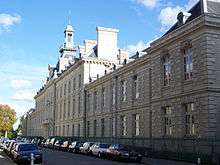Lycée Georges Clemenceau (Nantes)
The Lycée Georges Clemenceau, French pronunciation: [lise ʒɔʁʒ klemɑ̃so], usually called Lycée Clemenceau is a public secondary school located in Nantes, France, formerly known as the Lycée of Nantes. Inaugurated in 1808, it is the oldest secondary school of the town of Nantes and in the department of Loire-Atlantique.

It offers both a sixth-form college curriculum (as a lycée), and a post-secondary-level curriculum (classes préparatoires).
It is located next to a botanic garden (Jardin des plantes). Train and tram stations offer an easy access to the school for students. Furthermore there is a lovely chapel inside.
The Emperor Napoleon visited the Lycée on 9 August 1808. The school was rebuilt from 1886 to 1892 to a design by the architects Antoine Demoget and Léon Lenoir. Many famous people studied in Clemenceau, like the writer Jules Verne and the politician Georges Clemenceau who give his name to the school.
Famous Alumni
Writers
- Henri Anger (1907–1989), novelist
- Rene Guy Cadou (1920-1951, poet)
- Alphonse de Châteaubriant (1877-1951)
- Edmond Coarer-Kalondan (1909-1981)
- Tristan Corbière (1845-1865, poet)
- Marc Elder (1884-1933)
- Julien Gracq (1910-2007)
- Morvan Lebesque (1911-1970, also journalist)
- Jean Sarment (1897-1976, also actor)
- Marcel Schwob (1867-1905)
- Jules Verne (1828-1905)
- Jacques Vaché (1895-1919)
- Jules Vallès (1832-1885)
Politicians
- Yed Angoran, minister of the industry from Ivory Coast
- François Autain, senator and Secretary of State
- Louis Mathurin Babin-Chevaye, industrial and deputy
- Jean Babin-Chevaye, industrial and senator
- Robert Badinter, lawyer, minister of Justice, president of the Constitutional Council
- Mehdi Bazargan, 46th Prime Minister of Iran (1979)[1]
- Paul Bellamy, deputy-mayor of Nantes
- Aristide Briand, minister, president of the Council (prime minister) and Nobel Peace Prize
- Georges Clemenceau, journalist, senator and president of the Council (prime minister)
- Henri Lopès, prime minister of the Republic of the Congo
- André Morice, minister, parliamentary and mayor of Nantes
- Abdollah Riazi, 16th Speaker of the Parliament of Iran (1963–1978)[1]
- Jacques Sourdille, medicine professor and Secretary of State.
Painters
- Maurice Chabas
- Paul Chabas
- Jules Grandjouan (engaged dessinator)
- Emile Laboureur
- Amédée Dubois de La Patellière
- Maxime Maufra
- Jean Metzinger
- James Tissot
Musicians, dancers, cineastes and actors
- The brothers André et Georges Bellec (singers from the group les Frères Jacques)
- Yvan Dautin (singer)
- Jacques Garnier (dancer and choreograph)
- Jacques Grand-Jouan (cineaste)
- Thierry Fortineau (actor)
- Paul Ladmirault (compositor)
- Yves Lecoq (actor)
- Jacques Legras (actor)
- Olivier Messiaen
- François Tusques (compositor)
- François Verret (choreograph)
Industrial and engineer
- Louis Amieux
- Ernest Cassegrain
- Thomas Dobrée (shipowner)
- Eugène Dubigeon (engineer)
- Léon Jost (industrial)
- Louis Lefèvre-Utile (industrial)
- Alphonse Lotz-Brissonneau (engineer)
- Arsène Saupiquet
- Constant Say
- Georges Evano (architect)
- Pol Abraham (architect)
Doctors
- Félix Guyon (surgeon)
- Gustave Rappin (doctor)
Further reading
| Wikimedia Commons has media related to Lycée Georges-Clemenceau (Nantes). |
Books
- Jean Guiffan, Joël Barreau and Jean-Louis Liters dir., Le Lycée Clemenceau. 200 ans d'histoire ; Nantes, éditions Coiffard, 2008. ISBN 9782910366858
- Jean Guiffan, Le Péché de Nantes. L'abbé Follioley, dernier proviseur ecclésiastique (1890-1898), Éditions du Petit Véhicule, Nantes, 1998. Réédition, Le Dernier Prêtre-proviseur (1890-1898). "Le Péché de Nantes", 2007.
References
- Houchang E. Chehabi (1990). Iranian Politics and Religious Modernism: The Liberation Movement of Iran Under the Shah and Khomeini. I.B.Tauris. p. 108. ISBN 1850431981.
External links
- official site of the lycée Clemenceau